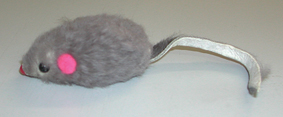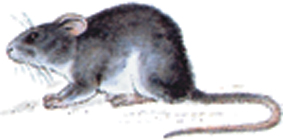| Approach: Independent |
Level:
Year 4
and year 8 |
|
| Focus:
Generating
possible design solutions
|
| Resources:
Toy mouse, instruction
card, ruler, eraser, answer booklet |
 |
5.6MB |
|
|
| Questions/instructions:

In
this activity you are going to design something for catching a pet mouse.
Imagine that a pet mouse got out of its cage. You want to catch it,
but you don’t want to hurt it. Your task is to design something
that will catch the mouse but not hurt it. You will have an instruction
card that tells you what to do.
Give each student a toy mouse, instruction card, ruler and eraser.
Before you start, have a look at the instruction card while I read it
through.
Read the instruction card.
You can start drawing your plan now. Remember, your plan should show
your own ideas, so work on your own and show your own ideas.
Hand out answer booklets to each student.
Pet
Mouse Instruction Card |
| The
pet mouse got out of his cage. You want to catch it but you don't
want to hurt it. Design something that will catch the mouse but
not hurt it |
| 1. |
Think
about what your mouse catcher will look like and how it will work |
| 2. |
Think
about the materials you will need for your muse catcher. |
| 3. |
Draw
some different views of your mouse catcher |
| 4. |
Label
your drawing s to show how the mouse catcher works and what it is
made of. |
| 5. |
On
your drawings, explain how your mouse catcher is designed so that
it will not hurt the pet mouse. |
|
|
%
responses
2004 ('00) |
| y4
|
y8 |
| How
many views are provided? |
two
or more |
34
(27) |
60
(61) |
| one
|
66
(73) |
40
(39) |
| How
clearly has the student communicated the way the mouse catcher is supposed
to work? |
|
|
very
clearly |
12
(1) |
26
(50) |
quite
clearly |
24
(19) |
34
(26) |
a
little |
42
(37) |
29
(20) |
not
at all |
22
(43) |
11
(4) |
| How
fully have the materials been identified? |
|
|
very
fully |
13
(7) |
28
(42) |
quite
fully |
34
(20) |
28
(28) |
a
little |
42
(36) |
33
(11) |
not
at all |
11
(37) |
11
(19) |
| How
clearly has the student managed to meet the requirement that the catcher
will not hurt the mouse, and explained this? |
|
|
clearly
met and clearly explained |
3
(0) |
18
(12) |
clearly
met but not explained |
13
(2) |
26
(25) |
possibly
met plus supporting arguments |
11
(4) |
7
(2) |
possibly
met but not explained |
45
(25) |
36
(54) |
requirement
clearly not met |
28
(69) |
13
(7) |
| Rate
the likelihood that the device will catch the mouse effectively: |
|
|
very
likely |
4
(2) |
15
(1) |
moderately
likely |
30
(11) |
29
(16) |
unlikely
|
66
(87) |
56
(83) |
Total
score: |
12–14 |
2
(0) |
16
(5) |
9–11
|
12
(6) |
25
(25) |
6–8
|
33
(11) |
27
(28) |
3–5
|
41
(40) |
27
(36) |
0–2
|
12
(43) |
5
(6) |
Commentary
About 35 percent of year 4 students and 60 percent of year 8 students
provided more than one view, communicated how the device was supposed
to work reasonably clearly and identified most of the required material.
Fewer succeeded in meeting the design criteria. There was a small improvement,
both for year 4 and year 8 students, between 2000 and 2004. |